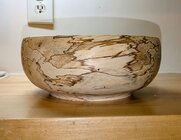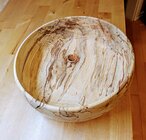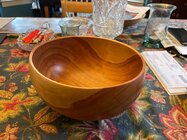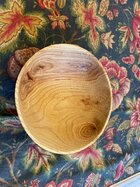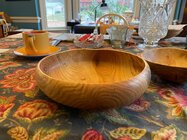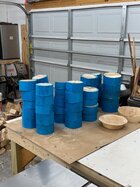Hi, I have some ~3' X 15" logs of pecan. They are from the tree that was growing in the middle of my shop which I eventually cut down cuz the roof I built around it was ... well basically a gaping hole. But I digress.
I cut open one of the logs the other day and found it was pleasantly riddled with spalt. Looks very nice. But the the wood is still wet. I roughed out a salad bowl and salad serving bowls and have stuck them in some paper grocery bags with wood chips. This is the first time I've done the 2 stage or the paper bag thing. I think I know the process from reading up on it. My question is, given spalt is live fungus and is very closely coupled with irredeemable decay, do I need to/is there anything I can do to arrest the spalting in the bag?
Secondly I have 3 more of those logs. I fear they will be mush before I get to them. I can't store them inside, but I could I guess put a tarp over them . Should I cut them into blanks now? I guess the answer to first question might help inform second question.
. Should I cut them into blanks now? I guess the answer to first question might help inform second question.
Also some nasty ass grubs or worms in there. Man those are gross. I guess it's better to get em out first other wise they end up on your face shield. I should probably read up on fumigating.
Thanks for any thoughts.
I cut open one of the logs the other day and found it was pleasantly riddled with spalt. Looks very nice. But the the wood is still wet. I roughed out a salad bowl and salad serving bowls and have stuck them in some paper grocery bags with wood chips. This is the first time I've done the 2 stage or the paper bag thing. I think I know the process from reading up on it. My question is, given spalt is live fungus and is very closely coupled with irredeemable decay, do I need to/is there anything I can do to arrest the spalting in the bag?
Secondly I have 3 more of those logs. I fear they will be mush before I get to them. I can't store them inside, but I could I guess put a tarp over them
Also some nasty ass grubs or worms in there. Man those are gross. I guess it's better to get em out first other wise they end up on your face shield. I should probably read up on fumigating.
Thanks for any thoughts.

